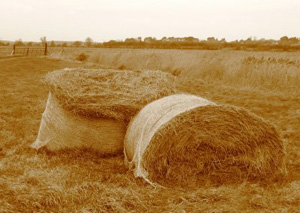Burying crop residues at sea may help reduce global warming, according to researchers in the USA. They suggest that transporting millions of tonnes of bailed up cornstalks, wheat straw, and other crop residues from farms, and burying it in the deep ocean will lock up huge amounts of carbon. The carbon would otherwise be released into the atmosphere as the crops rot. Of course, such a macroengineering project would require energy for harvesting of the residues, bailing, transportation, and associated effort.
Writing in the journal Environmental Science and Technology, Stuart Strand of the College of Forest Resources, at the University of Washington, in Seattle, Washington, together with Gregory Benford of the Department of Physics and Astronomy, at the University of California, in Irvine, suggest extensive research be carried out into this approach to so-called carbon sequestration.

Professor Stuart E. Strand
Atmospheric carbon dioxide levels are rising because of the increasing amounts of the gas released by human activities involving the burning of fossils fuels. Simulations suggest that the associated rise in global average temperatures associated with the greenhouse effect of this gas will have catastrophic consequences for people and life on earth.
As such, any large-scale, or macro, engineering project aimed at ameliorating the effects of rising carbon dioxide levels will have to process large amounts of carbon efficiently with little energy use. It will also have to be a repeatable process that can be done again and again to counter the effects of decades of environmental neglect. Moreover, the carbon must remain sequestered and so unable to re-enter the atmosphere for thousands of years. If it is not it will simply be deferring the problem for future generations. Any such solution must be implemented soon, the team suggests.

Gregory Benford
According to Strand and Benford, the only approach that meets all these criteria is the removal of crop residues and their burial in the deep ocean. In their research paper, they show that this method to be 92% efficient in sequestration of crop residue carbon. This, they say, far outweighs any benefits from converting those waste materials into biofuels (just 32% efficiency) or carbon sequestration in soil (a mere 14% efficient).

Wasted hay bails could reverse global warming (Photo by David Bradley)
Deep ocean sequestration can potentially capture 15% of the current global carbon dioxide annual increase, the researchers calculate, returning that carbon back to deep sediments, confining the carbon for millennia, while using existing capital infrastructure and technology.
Further reading
Env. Sci. Technol., 2009, in press
http://pubs.acs.org/doi/abs/10.1021/es8015556
Professor Stuart E. Strand homepage
http://faculty.washington.edu/sstrand/
Gregory Benford homepage
http://www.physics.uci.edu/faculty/benford.html
Suggested searches
carbon sequestration
carbon dioxide
climate change
global warming